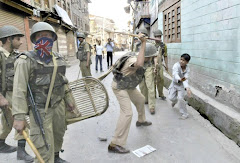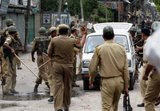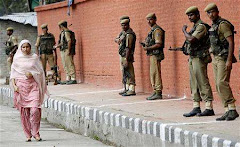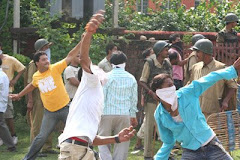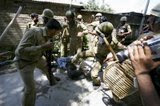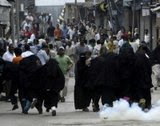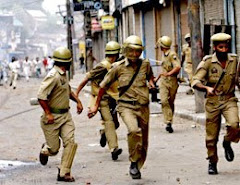Courtesy: Daily Kashmir Times By Anuradha Bhasin Jamwal
It is not known whose agenda Sinha was pursuing. But that he had the partial, if not full, backing of the centre all along even as power changed hands from BJP led NDA government to Congress led UPA government in New Delhi, was quite evident. Despite his objections and the prolonged confrontation over yatra duration, Mufti had to give in after centre's insistence. That time, Congress was in the saddle in New Delhi. After Ghulam Nabi Azad took over as chief minister of the coalition government in November 2005, it was known in the official circles that Azad was using Sinha as a counter weight against Mufti. But how does a constitutional head of the state become such a super power without backing from somebody at the power centre? The PDP kept resisting efforts to transfer the land to SASB for three years right up till March 2008, as is evident from reports about the coalition members confronting each other on this issue. Then what happened between March 2008 and May 2008 to have prompted the PDP to give up its stand, that too at the fag end of Sinha's career? Sinha's tenure ended on June 2 but was extended by a few weeks during which resentment against the land transfer was building up. Congress spokesperson Jayanti Nataranjan maintained, only after Sinha's exit from Jammu and Kashmir, that he was a communalist, pointing out at his equally admonishable role in Assam. That it took over four years for the Congress to understand Sinha's troublesome quality is difficult to digest. Was Congress oblivious of his past, also even of Indira Gandhi government rejecting his name for army chief owing to his right wing leanings. If such facts were known, they were conveniently ignored for whatever reason, making the constitutional head of Jammu and Kashmir all powerful and almost unquestionable. Anyhow, the notion of the land transfer as a design to bring about demographic change in Kashmir did not have roots in Islamic fundamentalism but in Sinha's sinister moves that created suspicions. Whether or not there was a design to do so in so inhospitable a terrain, there were legitimate reasons for insecurity and anger. It has been contended that 800 kanals of land was not enough space to effect any kind of a demographic change in a place where 99 percent population was Muslim. Certainly one is well aware that 800 kanals of land in the possession of Amarnath Shrine Board headed by a non state subject may not be enough to bring about a demographic change but one has to keep the sequence of events in mind as well to understand the skepticism and insecurity of the Kashmiris for which Sinha alone is to be blamed. Whether one calls it diversion or permanent transfer, the impact of such a move on the psyche of the people, who had earlier agitated against offering vast tracts of land in Gulmarg to hoteliers and big companies from outside the state, was the same. Sinha had already made himself a suspect in the eyes of the people and his moves were being viewed as a well conceived agenda against the locals. 800 kanals of land may not have been sufficient to even settle a few non state subjects. But this could well have been the beginning with a person as constitutional head of the state who had become too demanding. After all Gaza strip was created bit by bit, not overnight. The psychological impact of such fears coupled with the pent up anger of the people due to continuum of suppression, human rights abuse and increased alienation and their increasing disillusionment with the peace process is what led to a spontaneous agitation in the Valley. The final spark was provided not as much by Islamists, petty politicking between different parties, the unity moves of the two Hurriyats or their creation of the Action Committee Against Land Transfer but by the Chief Executive Officer of the SASB, Arun Kumar. Responding to Muzaffar Hussain Beig's remarks about being arm twisted into okaying the deal, at his venomous press conference on June 17, Arun Kumar stated that the land transfer was 'permanent'. Arun Kumar's press conference became significant for the fact that his remarks became the final provocation, setting the tone of a massive agitation in Kashmir. The reason was not simply the 'permanent land transfer' he referred to, remarks which he later tried to distance from, but also his provocative comparison between Haj pilgrimage and Amarnath pilgrimage as also his insistence that the SASB would make the Amarnath yatra a permanent feature to accommodate the increasing number of Hindus in the world. (Interestingly Arun Kumar's mysterious role also comes into focus on an earlier occasion in 2005 when the initial proposal of allocation of 3600 kanals of land was sent to the forest department of the state. His wife Sonali Kumar, who happened to be the forest commissioner that time blindly gave the proposal a green signal. When Mufti learnt of this, he cancelled the order, which as per norms should have been cleared by the cabinet and also on the grounds that transfer of forest land would amount to violation of supreme court directive.) Arun Kumar's outburst strengthened the fears and insecurities of the people whose obsession with history of Palestine invoked fears of this being the first step towards creation of a Gaza strip here. PDP pulled out of the government on June 28 and the next day governor NN Vohra wrote to the chief minister that the Board was not interested in pursuing the land if the state government could give an assurance that it would create suitable facilities for the yatra. Two days later, the cabinet of a minority government met to cancel the land transfer order. There were two reasons to revoke the order and it was obvious that the pressure to do so had come from the Centre. First, the land agitation had strengthened the hands of the separatists and New Delhi felt that any further delay would totally fritter away the gains of the peace process. This was not the first agitation against government policies in the Valley but the fact that it was assuming the shape of a revolt, especially at a time when Indian government was hoping to cash in on the decreased militancy related violence and the weakening of the separatist leaders. It had rung alarm bells. Secondly, there was finally a realisation that the decision to transfer land had been wrong and also of the damage that had been done by Sinha and the land deal. By June 19, violent protests, brutally dealt with, had begun in the Valley. On June 27, Friday, complete bandh was observed in Valley to both oppose the land transfer issue and the killing of two persons in police firing during protests in Srinagar's down town. After the Friday afternoon prayers in various mosques of the Valley, where imams and separatist leaders called for assembling on the roads in protest against the land transfer, thousands of people all over the Valley descended on the roads. In Srinagar, the summer capital of the state, alone over a lakh people were part of different peaceful demonstrations. The police and the security forces, in view of the killings in police firing, had probably decided against any direct confrontation with the protestors and allowed them to move. Most of them converged at Lal Chowk, some hoisting green flags at the historic crossing's Clock Tower. Slogans of 'azadi' dominated the scene. But also heard were pro-Pakistan and religious slogans. The agitation against land transfer had become an occasion for political revolt, suppressed by years of indifference and to some extent by an increasing weakening of the separatist leadership. But when slogans of 'ham kya chahte hain..azadi' turned into 'azadi ka matlab kya.la allah-al-allah' the reaction was just the opposite in Jammu region where an agitation was waiting in the wings for the collapse of state administration. When some Kashmiri youth hoisted green Islamic flags at Srinagar's historic Lal Chowk and electronic media gave liberal coverage of that very incident, common masses in Jammu, unmindful of the history of events, perceived it as a war between two religions, not as a people's war for their land or even as people's struggle to decide about what happens on their land. In 1990s massive agitations had rocked in the Hindu dominated Katra town, the base camp of the Vaishno Devi pilgrimage, of Jammu region against the Vaishno Devi Shrine Board's move to build a motorable road to the shrine. It went against the local interest and protests were supported and justified. When protests for similar reasons took place in Kashmir, they were given a religious colouring. The green flags and Islamic slogans only further contributed to this religious paranoia. The PDP's pull out from the government on June 28 coincided with NN Vohra taking over as the new governor on June 24, left behind a one legged Congress government. The latter failed to offer any explanation either for the land transfer or the need to cancel the order, following Vohra's letter to the chief minister Ghulam Nabi Azad stating that the SASB was not interested in pursuing the land if the state government could give an assurance that facilities for pilgrims would be taken care of by it. Because the Congress was busy politicising the issue and getting even with PDP, both washing dirty linen in public, the government had no explanations to offer to the people either in Kashmir or Jammu, the constituency which Congress was eying. This seems to have acted as a catalyst for the agitation in the winter capital of the state. The cancellation of land transfer order had an adverse fallout in Jammu region where the Sangh Parivar, prompted by its mentor Lal Kishen Advani, was already up in arms against what they had begun to call 'surrendering to separatists and anti-nationals'. In Kashmir the religious slogans, green flags and pro-Pakistan slogans, as always, were expressions of an anti-India sentiment. The anger had both a history and reason. In Jammu, Sangh Parivar sought to legitimise the agitation on grounds that this was an expression of Jammu sentiment, a euphemism for Hindu sentiment. Peoples' sensibilities, nurtured on the notion of discrimination to Jammu for years, were easily whipped by the panic inspired by the 'unity' displayed by the Kashmiri leadership including the mainstream political parties on the issue. Not many coming out on the streets to protest knew the basis of the agitation. The popular sentiment was anti-Kashmir and anti-Muslim, fed by myths that Hindu land had been taken away by the Muslims which the Sangh Parivar had so cleverly perpetuated. It took three days for the Congress ministers to respond to the agitation in Jammu where they pursued a more apologetic posture, maintaining that the land was sought by the former governor, so it was transferred, the new governor didn't want it, so it was cancelled. Two days later, chief minister Ghulam Nabi Azad addressed a hurried press conference, maintaining that 'this was a win win situation for Jammu'. The lack of any explanation, about what the land transfer signified, what its repercussions would have been, why it was opposed in Kashmir Valley and how the cancellation of the order would impact or not impact the yatra, created conducive conditions for the fertility of the Sangh Parivar propaganda, something that these groups had been waiting for a long time. Azad's remarks on the day the land transfer order was cancelled - that the agitation in Kashmir is over a non-issue - itself legitimised the agitation in Jammu for revoking the cancellation of the previous order i.e restoring the land back to the SASB. Virtually, the government had no story to tell. Or, it didn't want to. But the media had, especially the local electronic channels, without any exception, in Jammu. They ran almost a round the clock 'soap-opera', projecting unknown figures of the saffron brigade mouthing their propaganda, raising slogans or burning effigies. The meager protests being held in small mohallas were getting almost a live telecast. These were the only voices people heard and their only source of information, rather disinformation. At the same time, in Kashmir, there is need for realisation that even though religious slogans are popular expressions of resentment and alienation against India, they can create insecurities in the minds of the other communities of the State. The valley centric politics have been pivoted around mosques and religious slogans, not only in the last two decades, but since much before even during the times of Sheikh Abdullah whose obsession with the Hazratbal politics was too conspicuous. In fact, the use of mosques to mobilise people for political purposes or protests has become an accepted part of life. It is not necessary to justify that. If the plural fabric of the State has to be kept intact in its harmonious mould, it is time to shun politics that can create insecurities and divisions. Violent protests in both the regions of the state have ended since long and the ice has melted, at least on the surface. But not without taking its toll. The two counter agitations cost individuals thousands of crores of rupees and severely hit the state's economy. Health care and education were severely hit. And added to this was psychological impact that violence and hatred caused in the long run. But more significant is the damage that has been done with the creation of communal and regional divides which does not augur well for the social fabric of the state or for eventual peace. These have mellowed down but have not totally been wiped out. Without understanding and questioning the deigns of fundamentalists and vested interests on both sides, especially the Sangh Parivar, there can be no lasting and enduring bridge between regions and communities. While it is important for secular elements from all sides to come forward and burn the midnight oil to dispel all kinds of propaganda as also prevent a repeat of the situation witnessed in this state last summer; it is also necessary at this juncture to introspect what happened and why it happened before one gets down to working on creating a space for healing. An ideal solution, ultimately, would be de-linking State and politics from religion. But before that lies the onerous task of dispelling myths and building bridges for a consensus on that. -(Concluded)














